Ossett - the history of a Yorkshire town
- ossett :
- Home :
- What's New :
- Picture Gallery :
- WW1 Remembrance :
- WW2 Remembrance :
- Contact :
August 4th 2014: 100 years since the start of the Great War
At 11pm on Tuesday 4th August 1914, Britain declared war on Germany as a result of Germany's invasion of neutral Belgium. The next day, soldiers of the Territorial Army were recalled back to Ossett from their summer Bank Holiday training camp in Whitby. By that same day, 83 of these Ossett soldiers had received their mobilization papers and they marched from the Drill Hall in Station Road to their billet at the Town Hall in Wakefield.
En route, the Ossett soldiers were cheered by large crowds and local tradesmen showed their support by giving the men sandwiches, tobacco and cigarettes. Later on that Wednesday evening, the bells at Ossett Town Hall rang out loud, attracting a crowd of several hundred people where they heard the Ossett mayor, Councillor Harvey Robinson, read eleven royal proclamations from the town hall steps. At the end of the 20-minute reading, the crowd responded enthusiastically to the mayor's request for the singing of "God Save The King."
We believe that the majority of these men served in the 1st/4th Battalion of the King's Own Yorkshire Light Infantry, and specifically 'D' Company, which was largely made up of men from Ossett and Horbury. In effect, a group of "Ossett Pals" who trained, fought and died together. Many of these men were gassed in their trenches in late December 1915 and many more died on the beaches at Nieuport on the Belgian coast, near Ostend in July 1917. All these men were 'Saturday Soldiers' or Territorials. Those men from the Territorial force who hadn't signed up for overseas service became part of the 2nd/4th Battalion, King's Own Yorkshire Light Infantry, and were designated for home service, but they too were soon to find that they were needed on the Western Front and were eventually sent to fight in France.
Both sides predicted, and publicly stated, that the war would be over by Christmas 1914, and the Ossett men who went to war in 1914 believed that. However, as we know, in reality, the war lasted for four long years and another three months with a tragic loss of life. Conscription was introduced in January 1916 for all single men and childless widowers aged between 18 and 41 years of age. This was changed in May 1916 to include all men aged 18 to 41 years of age. The carnage and loss of men on the Western Front was so great that in April 1918, the conscription rules were changed yet again so that all men, aged between 41 and 50 years, could now be conscripted, but with an allowance made for for an extension of the age limit up to 56 years. In addition, provision was made for the cancellation of most existing exemptions, if the need arose. Controversially, there was also provision for the extension of conscription to include Ireland; a country in the throes of independence troubles after the Easter Rising of 1916.
At least 320 Ossett men lost their lives during WW1 and these were mainly young men aged under 40 years of age. In total, the dead numbered about 2% of Ossett's population at that time, but many more would return home wounded, maimed or suffering from shell-shock. Most were reluctant to speak about the horrors that they went through, if they were lucky enough to survive.
Presented here are some of the stories of those Ossett men as we try to remember them 100 years later. In the right-hand sidebar of this web page is an alphabetically arranged list of names of the Ossett soldiers and sailors who died during WW1. In addition, in the left-hand sidebar, there are links to a series of articles by Ossett historian David Scriven about life in Ossett during WW1. There are also the stories of Soldiers Who Survived, Medal Winners, Conscientious Objectors and the Ossett women who served as nurses during WW1.
Most us will have ancestors who fought in the Great War and it touched the lives of the majority. I hope you will find something of interest on the stories presented here. Just click on the name in the right-hand sidebar (or left-hand sidebar) and a new page will open with their story, sometimes with a picture, and in most cases, with details of their tragically short lives and in what action they were killed. Many of the soldiers and sailors featured here lie where they died and sadly their bodies were never recovered.
If any of these brave men are your ancestors and you have corrections, information, pictures, stories about them that you would like us to add, I would be delighted to do so. Please contact me via the CONTACT page above. In fact, please contact me if you have any thoughts about this WW1 Remembrance project, I would love to hear what you think.
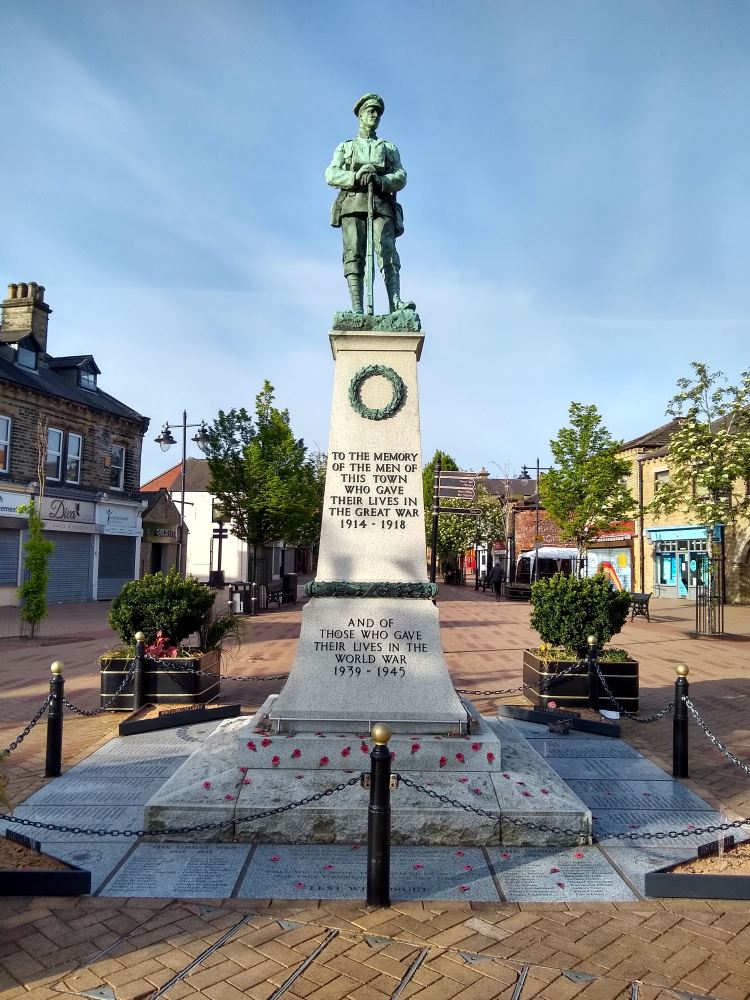
Above: Ossett War Memorial, now located in the Market Place, but originally located at the bottom of Kingsway near Ossett Town Hall.
Ossett’s War Memorial was unveiled on the 11th November 1928 exactly ten years after the Armistice was signed. There are no names on the Memorial, perhaps because there were so many who had given their lives for King and Country. There were however 230 names listed in the programme for the dedication service of the Memorial, and it is this list which has informed the preparation of biographies of these men 100 years later in 2014. The War Memorial was but one of several Ossett memorials, some in the form of Rolls of Honour, dedicated to the memory of those brave men.
South Ossett at that time, and for centuries before, considered itself to have its own identity. The parish erected its own memorial to the men of South Ossett Parish who gave their lives in the conflict. The Memorial stands today in the South Ossett Christ Church Cemetery extension on Manor Road. It commemorates 92 men, including one man, Harry Beetham, whose name does not appear on the Ossett War Memorial dedication. A South Ossett Roll of Honour has a place on the wall of Ossett Library and records the names of those men, their regiments, address and the date of their deaths.
The Churches too were anxious to honour those in their respective congregations who had made the ultimate sacrifice. Ossett Holy Trinity Parish Church, has a Roll of Honour in the form of a wall plaque which honours 105 men including one man, Willie Giggal, whose name does not appear on the Ossett War Memorial dedication.
In a similar fashion the Wesleyan Chapel, which once stood Wesley Street, contained the names of 23 men, including three men, Herbert Boocock, Bernard Clayton and Clifford Ibbotson, whose names do not appear on the Ossett War Memorial dedication. The United Methodist Church (UMC), Dale Street Roll of Honour records the men who served and survived but in addition it honours eight men who lost their lives including one man, George Oldroyd, who is not recorded on the Ossett War Memorial Dedication. Also included is Wilfred Audsley, but no WW1 death record has been found for him. He is believed to be the brother of Percy Audsley who was killed in WW1.
The Congregationalists once of Ossett Green and also of Gawthorpe and Flushdyke each established their Roll of Honour to remember the men of their respective Churches. The Ossett Green Roll remembered 15 men, including one man, William Dews, whose name was not included on the Ossett War Memorial dedication. Gawthorpe & Flushdyke Congregational Church named seven men including two men, Walter Chappel and Wilfred Midgely, whose name was not included on the Ossett War Memorial dedication.
The Baptists also remembered the men from their congregations who lost their lives. The Central Baptist Church Roll of Honour remembered 14 men, including two, William Tomlinson and Fred Ward whose names were not included on the Ossett War Memorial 1928 Dedication. The South Ossett Baptist Chapel which once stood on Baptist Lane off Teall Street, recorded five of its congregation who were lost in the conflict, including one man, Alfred Buckett whose name was not included on the Ossett War Memorial. Four of these men are now remembered on a Memorial stone at St John’s Methodist Church, South Parade, South Ossett. Following the desecration of the Baptist Lane Graveyard the fifth man is now remembered at Stonefell Cemetery in Harrogate.
On the 11th November 2014, Ossett Academy, formerly Ossett Grammar School, commemorated its former students who lost their lives in WW1 and WW2 by erecting a new memorial in the school grounds. The memorial records the twelve former students who lost their lives in World War 1. Seven of those men were born or lived in Ossett and biographies are included amongst others in the right hand side bar.
Biographies for these seven men and for the other five men, from Horbury, Netherton and Middlestown, are now also included under the heading Ossett Grammar School WW1 Memorial in the left hand side bar.
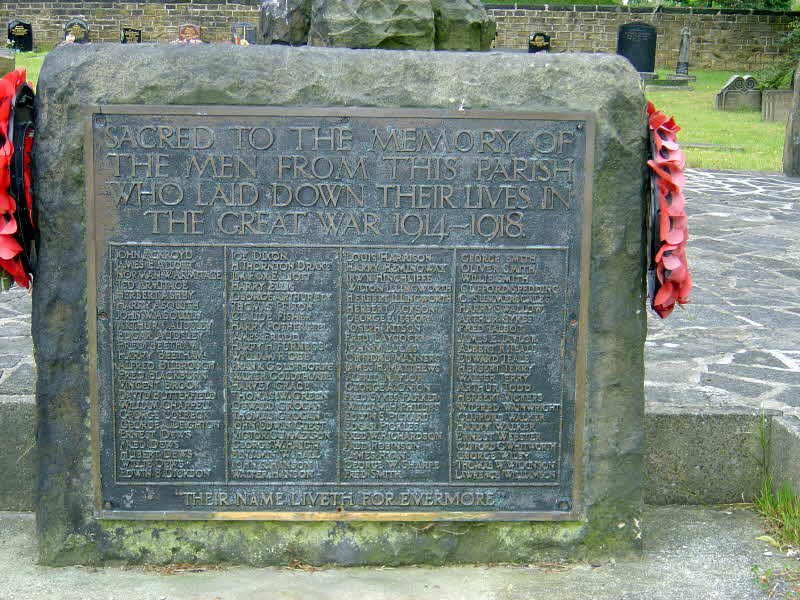
Above: The remembrance plaque on the South Ossett War Memorial, which is located in the South Ossett Church cemetery, Manor Road, Ossett.
Thirteen men, therefore, are remembered on the South Ossett and the Church Memorials or Rolls whose names do not appear on the Ossett War Memorial dedication. It is not uncommon for variations like this to be found in other parts of the country. The men and women who had the responsibility for the dedication of the Ossett War Memorial had to rely on War Office information and casualty lists announcing the deaths of men serving in the armed forces. The Casualty Lists were not posted until members of the deceased, or missing, soldier’s family had been notified and the local authorities also relied on those families to offer information about their loved ones.
Notwithstanding, it is difficult to understand why thirteen names were included on some Memorials and Rolls but omitted from the Ossett War Memorial, which was not dedicated until 1928.
Another key source of information for the biographies has been the "Ossett Observer" which, at the time, published reports and short obituaries of many of the men who lost their lives in the Great War. Several years ago many of these reports and obituaries were identified and copied by Dorothy Wainwright, once of Ossett Library, but now enjoying her retirement. More recently these have been added to by Jean Parkin and Susan Emmett, both of Ossett Library, to establish an archive of those reports and this has been of immense value in preparing the biographies. The "Ossett Observer" archive collection at Ossett Library has not yet been digitised and has to be accessed by microfiche reader. We developed a fast way of collecting data for our WW1 project by digitally photographing the microfiche screen at high resolution and then reading the information later after it was transferred to our personal computers. Some of the pictures in the biographies presented are not of the highest quality, having been copied in this way from a 100 year-old newspaper, but represent our best endeavours with a little help from Photoshop.
The "Ossett Observer", however, includes a further fifteen Ossett men who died in the Great War, but whose names are not recorded on the Ossett War Memorial dedication. The final sources contributing to our 2014 Memorial were the records of the Commonwealth War Graves Commission (C.W.G.C) and the U.K. Soldiers Died in the Great War 1914-1919 (S.D.G.W). These sources recorded over 100 men with an Ossett connection who lost their lives as a result of action in World War 1. None of these 100 men were remembered on the Ossett War Memorial Dedication. This Ossett connection included men whose army service records indicated that they were born or lived or enlisted in Ossett.
Many of those enlisted in Ossett came from neighbouring towns and villages and so are not included in our numbers. However, our research revealed a further 57 men on the C.W.G.C and S.D.G.W listings who lost their lives and who were born or lived in Ossett. These men, and others with an Ossett connection whom we found mentioned in other local newspaper obituaries were not included on the Ossett War Memorial, but biographies of these men have now been completed and are included in the links on the right hand sidebar and also in our 2014 Memorial Database included below.
In total therefore this research, 100 years on, and with the benefit of hindsight, and huge technological advancements, has identified 85 additional Ossett men who lost their lives for King and Country in World War 1. The histories of these 85 men reveal no significant differences to the histories of those 230 men who were remembered on the Ossett War Memorial dedication. I hope therefore that these biographies and supporting articles will stand as a 2014 - 2018 Memorial of the 315 Ossett men who lost their lives, so that we may live ours.
Also included are the stories of four Ossett Conscientious Objectors in this work. It would be inappropriate for us to make any comment whether including these men is politically incorrect. However, military tribunals were a part of everyday life during WW1 and there were plenty of men in the U.K. who refused to take up arms because of religious or political convictions. Please read their stories and then decide for yourselves whether they were right or wrong to take the stance they did.
There is no comment about the conduct and competence of the British Generals who led these brave men into battle. The phrase "Lions led by Donkeys" was widely used to describe the actions of men like Sir Douglas Haig and TV programmes like "Blackadder" have reinforced this popular view. This is an entry from Haig's diary for the 4th September 1916, where he famously complains about men of the 49th (West Riding) Division, which contained, in 148th Brigade, the Ossett men of the 1st/4th Battalion of KOYLI:
“Monday, 4 September : I visited Toutencourt and saw General Gough. The failure to hold the position gained on the Ancre is due, he reported to the 49th Division. The units of that Division did not really attack and some men did not follow their officers. The total losses of this Division are under a thousand! It is a Territorial Division from the West Riding of Yorkshire. I had occasion a fortnight ago to call the attention of the Army and Corps Commanders (Gough and Jacobs) to the lack of smartness, and slackness of one of its Battalions in the matter of saluting when I was motoring through the village where it was billeted. I expressed my opinion that such men were too sleepy to fight well, etc. It was due to the failure of the 49th Division that the 39th (which did well and got all their objectives) had to fall back.”
Whilst Haig may have been correct about the saluting, he was wrong about everything else and Captain P.G. Bales, most definitely saw things rather differently, when he wrote this in the "History of the 1st/4th Battalion, Duke of Wellington’s West Riding Regiment: 1914 - 19". At the time, the 1st/4th Battalion, Duke of Wellington's Regiment were in the 147th Brigade of the 49th Division:
“It is not the purpose of this book to criticise as a general rule, but some slight exception must be made in connection with the attack on September 3rd. At the time there was a widespread belief, which was certainly held by most of the higher authorities, that the Battalion never gained its objectives. This was wrong. A and B Companies reached, and cleared the enemy from, the whole of the first and second objectives; it is true they did not occupy the whole of them, but that was due simply to lack of men. For more than two hours there were no Germans in either of the lines which the Battalion was ordered to capture. These facts are clearly proved, not only by the evidence of the men who carried out the assault, but also by the German official report on the action.”
It is better that you draw your own conclusions about the British and also the French Generals as to whether their WW1 strategy was appropriate or not. Much has been written on the subject and it is fair to say that Allied tactics did improve as WW1 ground on. Sadly, it was too late for those men who went 'over the top' on the 1st July 1916, the first dreadful day of the Battle of the Somme. By the end of the day, the British had suffered 60,000 casualties, of whom 20,000 were dead: their largest single loss. Sixty per cent of all officers involved on the first day were killed.
IN GRATEFUL MEMORY OF
The Ossett Men Who Lost Their Lives In The Great War
1914-1918
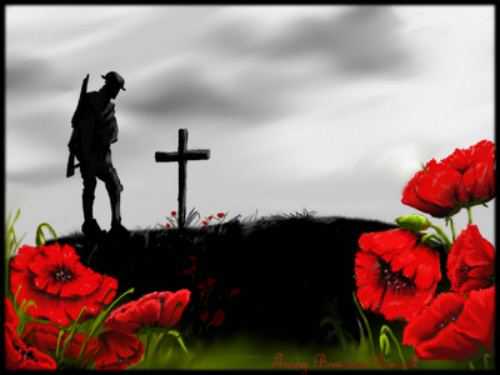
The project to research and write biographies for the Ossett men who sacrificed their lives in the Great War began in January 2014. The objective was to complete as many biographies as possible before the 4th August 2014, the 100th anniversary of Great Britain's Declaration of War against Germany. The research has continued beyond that date and, so far, 315 Ossett men, soldiers and sailors, who were killed in World War 1 have been identified. This is 85 more than the number on the dedication for the unveiling of the Ossett War Memorial on the 11th November 1928. All of these brave men deserve to be remembered and the biographies for each Ossett soldier and sailor who made the ultimate sacrifice so that we may live our lives has been researched and written.
But, 100 years on, it also seemed proper to construct a 2018 Ossett Roll of Honour to include those men who, for whatever reason, were not properly honoured in 1928. What better way than to take a lesson from the past and use the template of the South Ossett Parish Roll of Honour which, in addition to the man's name, included his Ossett address, Regiment and date of death of the South Ossett Parish soldier or sailor.
The www.ossett.net Great War, 1914-18, Ossett Roll of Honour has extended that concept to include the name and much more summary information about each of those men. Information which tells much about their life, from birth to death. It will show that their lives were, more often than not, chaotic and their deaths premature. It will show that they loved and were loved. It will show that they would be missed by mothers, fathers and often by a great many siblings. Wives, children and grandchildren would grow old without knowing what we now experience thanks to their dedication, bravery and sacrifice. These men deserve never to be forgotten.
Alan Howe contributed to the WW1 and WW2 biographies on ossett.net, mostly by providing the family history information for each biography and in very few instances some additional detail. Sadly, some of this information was inaccurate and has had to be corrected.
All these biographies were subsequently edited, illustrated, completed and written by me Stephen Wilson before being uploaded to this website. The biographies are copyright ossett.net as stated, and not in the ownership of Alan Howe. However, since they have been widely shared by Howe with my permission, I have no objection to his further usage.
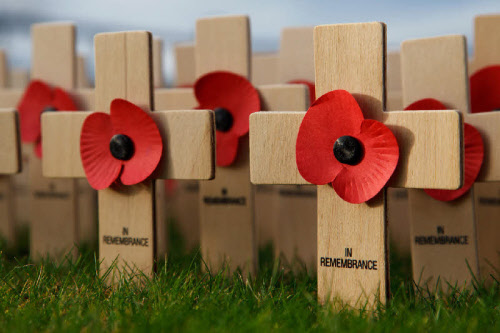
Anthem For Doomed Youth
What passing-bells for these who die as cattle?
Only the monstrous anger of the guns.
Only the stuttering rifles' rapid rattle
Can patter out their hasty orisons.
No mockeries now for them; no prayers nor bells;
Nor any voice of mourning save the choirs,
The shrill, demented choirs of wailing shells;
And bugles calling for them from sad shires.
What candles may be held to speed them all?
Not in the hands of boys, but in their eyes
Shall shine the holy glimmers of good-byes.
The pallor of girls' brows shall be their pall;
Their flowers the tenderness of patient minds,
And each slow dusk a drawing-down of blinds.
Wilfred Owen (18 March 1893 - 4 November 1918)
Written in 1917, when Owen was a patient at Craiglockhart War Hospital in Edinburgh, recovering from shell shock.
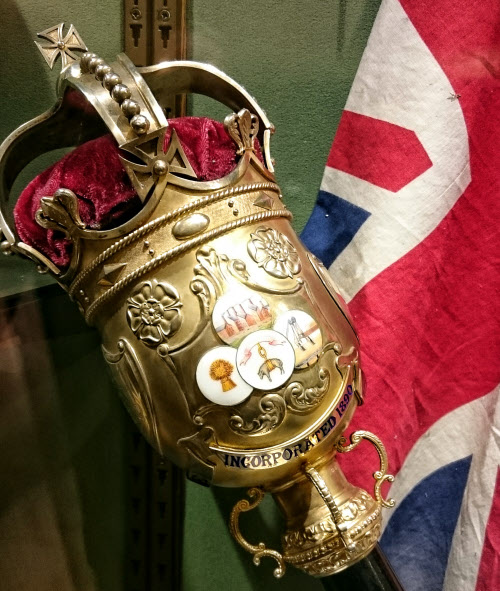
Ossett Borough Council Mace
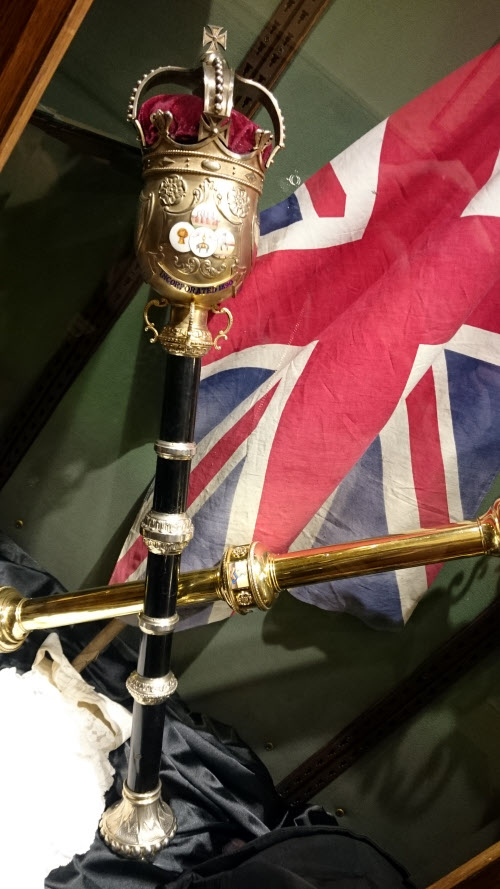
Above: On the 14th June 1920, G.H. Wilson, Esq., J.P. (Mayor of Ossett 1894-95), presented this Mace to the Borough of Ossett to commemorate the signing of the Peace Treaty after the Great European War, 1914-1918. Pictures courtesy of Anne-Marie Fawcett.
Copyright Notice
This website and its content is copyright of Stephen Wilson © ossett.net 2011 - 2021 under the Copyright Designs and Patents Act 1988.
All rights reserved.
Any redistribution or reproduction of part or all of the contents in any form is prohibited other than the following:
- You may print or download to a local hard disk extracts for your personal and non-commercial use only
- You may copy the content to individual third parties for their personal use, but only if you acknowledge the website as the source of the material
You may not, except with my express written permission, distribute or commercially exploit the content. Nor may you transmit it or store it in any other website or other form of electronic retrieval system.
Ossett in WW1
- 1914 - Ossett at War
- 1915 - The Home Front
- 1916 - The Big Push
- 1917 - The Tide Turns
- 1918 - Finally Victory
- 1919 - The Aftermath
WW1 Stories
WW1 Ossett Nurses
- Nursing in the Great War
- VAD Nurses at Work
- Mary Ethel Archer
- Constance Elliot-Birks
- Susannah M. Campbell
- Ethel Clay
- Louisa Hanson
- Jessie Jaggar
- Gladys Mary Jessop
- Dorothy Pollard
- Clara Renshaw
- Esther Hannah Smith
- Marian Walker
- Norah Ward
WW1 Soldiers Who Survived
- Sydney Beauchamp
- Bennett Brook
- John Etty
- Clifford Illingworth
- Fred Littlewood
- The Land Brothers
- The Long Brothers
- Albert Newton
- Joseph Richardson
- Arthur Richmond
- Newman Summerscales
- Benton North Wilby
Ossett WW1 Medal Winners
- George Bradley, MM
- Horace Brooke, DCM
- John W. Byram, DCM
- Joseph Charlesworth, MM
- H. Noel C. Davies, MM
- John Daykin, MM
- Robert Ellingworth, DCM
- Arthur Hutchinson, MM
- Lt. Charles Kendall, MC
- Clifford Moiser, MM
- Thomas North, MM
- Arthur Preston, MM
- Herbert N. Sheard, MM
- Cecil E. Smith, MM
- Harold Smith, MM
- Willie Squires, MM
- Noah Talbot, MM
- Albert Williamson, MM
- Gerald E. Wilson, MM
- W.L. René Wood, MC

Ossett Grammar School WW1 Memorial
- Eli T. Archer
- W. Henry Bedford
- Leonard Bell
- William Chappell
- Fred Earnshaw
- Thomas H. Graham
- Harry Ellis
- George Haigh
- Gordon Land
- Joshua Mitchell
- Bernard Noble
- George Sanderson
- Albert Teale
Ossett Rolls of Honour
- Ossett Roll of Honour - 1914
- Ossett Parish Roll of Honour - 1919
- Ossett Grammar School Roll of Honour - 1916
- Ossett's 18 Rolls of Honour
Ossett WW1 Officers
Conscientious Objectors
Links
Ossett WW1 Fallen
- John Akeroyd
- James E. B. Allott
- Charles H. Almond
- Harry Ambler
- Eli Townend Archer
- Fred Armitage
- Norman W. Armitage
- Herbert Ashby
- Fred Asquith
- Harry Asquith
- John W. Asquith
- John W. Atkinson
- Arthur J. Audsley
- Edgar Audsley
- Percy Audsley
- Wilfred Audsley
- Sam Balmforth
- Joseph Baron
- George A. Beaumont
- Fred Beetham
- Harry Beetham
- George H. Beever
- Harry Bickle
- Alfred Bilbrough
- George H. Bingham
- Charles E. Binns
- William Binns
- Jesse Birkinshaw
- Fred Blackburn
- William Blackburn
- Herbert Boocock
- Wallace Booth
- Harry Bowers
- Fred Brammer
- Joseph Broadhead
- Kisby Brook
- Vincent Brooke
- Leonard Brooke
- Harold Brown
- Alfred Mead Buckett
- Alfred Burrill
- David Butterfield
- William Butterfield
- Frank Clagget Caird
- Stephen Cannon
- Joseph Henry Carter
- James Chappell
- Walter Chappell
- William Chappell
- Willie Chappell
- Jason Oliver Clafton
- Robert Clarkson
- Bernard Clayton
- James W. Clayton
- Edward Clemenson
- William Coe
- George A. Coldbeck
- Allen Cooper
- Squire Cooper
- John William Couch
- George R. Coulson
- Horace Craven
- Albert Cudworth
- Edgar Daniel
- Harold Day
- George A. Deighton
- Cyril Denison
- Charles H. Derry
- Arthur Dews
- Ernest Dews (1)
- Ernest Dews (2)
- Fred Dews
- Herbert Dews
- William Dews
- Willie Dews
- Percy Dickens
- Edwin Dickson
- Joe Dixon
- Arthur Downing
- H. Thornton Drake
- Albert Duncan
- John T. Dunhill
- Frederick E. Eastwood
- Harry Ross Eastwood
- Jim Fox Elliott
- Harry Ellis
- John Ellis
- John W. Ellis
- Joshua John Ellis
- Laurence Ellis
- Walter Ellwood
- George Arthur Ely
- James Erly
- Claude Farrar
- Oscar Fell
- Thomas Felton
- Ernest Firth
- Claude Fisher
- Joseph S. Fisher
- William H. Fisher
- Walter Flesher
- Harry Fothergill
- Clifford Fozard
- James Frudd
- Harry H. Furniss
- William Cecil Gadie
- Charles B. Gara
- George Gawthorpe
- William Gawthorpe
- Herbert Gordon Gee
- William F. Gee
- Harold Giggal
- Leslie Giggal
- Willie Giggal
- Arthur Giles
- Harry Gillion
- Arthur Gillson
- George Glew
- Horace Glover
- Thomas Pyrah Godley
- Frank Goldthorpe
- Walter Goldthorpe
- Wilfred L. Goldthorpe
- Samuel K. Gothard
- Harvey Grace
- Logan J. Grace
- Thomas Grady
- John W. Gray
- Samuel Green
- Thomas W. Green
- George Griffiths
- Oswald Grogan
- Thomas Grogan
- John Edwin Guest
- Victor Gummerson
- George W. Haigh
- William Haigh
- Alfred H. Hall
- Benjamin W. Hall
- John William Hall
- Robert T. Hall
- John R. Hanson
- Walter Hanson
- George Hargreaves
- Joseph E. Harlock
- Louis Harrison
- Ernest Harrop
- Leonard Harrop
- Robert Harper
- James E. Hartill
- William I. S. Hartley
- Fred Gooder Hatfield
- John William Heaton
- George Hemingway
- Harry Hemingway
- George W. Hemsworth
- Clifford Hepworth
- William Hetherington
- Charles Hewitt
- Irving Hill
- Irvin Hinchliffe
- William Hinton
- George Edward Hirst
- Raymond Algeno Hirst
- William Holder
- Herbert Holland
- Albert Holmes
- Edward Humphrey
- Clifford Ibbotson
- Albert E. Illingworth
- Alma Illingworth
- Edward A. Illingworth
- Herbert Illingworth
- Wilby Illingworth
- C. Wilton Illingworth
- Thomas Isaacs
- Oscar Ivinson
- Anthony Jackson
- Herbert Jackson
- Ignatious Jackson
- Ernest Jessop
- George Edward Jessop
- John Edward Jordan
- George Johnson
- Herbert H. Johnson
- Harry Kellett
- Joseph Kitson
- Jesse Lamb
- Claude M. Lawrence
- Fred Laycock
- Harvey Lilley
- Andrew Lockwood
- Harry Lockwood
- Joshua Lockwood
- Stanley Lockwood
- Edwin Longley
- John M. Lucas
- Ernest Lythell
- Benjamin Malpass
- Edward Malpass
- Clifford Manners
- Jesse Marshall
- Harry Martin
- James H. Matthews
- Joseph Megson
- George Metcalfe
- Wilfred L. Midgley
- Joshua Mitchell
- Alfred Naylor
- Peter Nelson
- George Nettleton
- Harold Nettleton
- William Nettleton
- Herbert L. Newsome
- William Newsome
- Willie Newsome
- Thomas Newton
- Clarence Norton
- Walter Norton
- George Oldroyd
- George H. Oldroyd
- Gilbert S. Oldroyd
- George A. Onion
- Sam Padgett
- Sidney S. Page
- Fred S. Parker
- Joe Parkinson
- Arthur J. Parsons
- Robert E. Pennington
- William H. Phillips
- Edwin S. Pickard
- George A. Pickard
- Joe Pickard
- Harry Pickersgill
- Clifford C. Pickles
- Edgar Pickles
- John Pickles
- John Plant
- Albert Posliff
- James L Preston
- Richard Preston
- Charlie Raven
- Dorothy May Raven
- George F. Raven
- John H. Reynolds
- Joseph Reynolds
- Walter Reynolds
- Arthur Richardson
- Fred W. Richardson
- Lionel Richardson
- Bernard Richmond
- James Richmond
- John Harold Richmond
- Fred Riley
- Claude Robinson
- Fred Robinson
- George E. Robinson
- William Rollinson
- Lionel H. Rooke
- David Rothery
- George Thomas Rothery
- James Ryan
- George Sanderson
- Henry Sanderson
- Rowland Saxton
- Herbert S. Scott
- Llewellyn Scott
- Vincent Scott
- Frank Sharpe
- George W. Sharpe
- John W. Shaw
- Arthur Sheard
- John H. Sheldrake
- George A. Shillito
- Harry Simpson
- Ernest Smith
- Fred Smith
- George Smith
- John Smith
- Joseph Smith
- Oliver Smith
- Willie Smith
- Oliver Speak
- Clifford Spedding
- John Spedding
- Percy Speight
- Percival L. Spurr
- Thomas W. Spurr
- Ezra Squires
- Sam Stephenson
- Herbert Stokoe
- Lionel E. V. Straw
- Robert E. Stubbs
- John J. Stubley
- George Summerscales
- Newman Summerscales
- Percy Summerscales
- Herbert Sutcliffe
- Harry Swallow
- Arnold Swithenbank
- Arthur Sykes
- Fred Talbot
- George W. Talbot
- Joe Tattersfield
- George H. Taylor
- James E. Taylor
- Albert Rayner Teale
- Edward Teale
- Frank Terry
- Herbert Terry
- Walter Terry
- Horace C. Thompson
- Richard G. Thompson
- William H. Thompson
- Henry Tingle
- Arthur Todd
- Levi Tolson
- William Tomlinson
- Archer Townend
- Gerald Townend
- Walter Turner
- Ernest Vernon
- Herbert Vickers
- Harvey Wainwright
- Norman Wainwright
- Wilfred Wainwright
- Clifford Walker
- Frank Walker
- Harry Walker
- Victor Walker
- Daniel Ward
- Fred Ward
- John Mercer Ward
- Joshua Ward
- Ernest Webster
- Israel B. Westerman
- Willie P. Whitaker
- Arthur White
- Charles L. Whitehead
- John J. Whitehead
- Clifford Whitworth
- George Wilby
- John W. Wilby
- Thomas W. Wilkinson
- Alfred Williamson
- Lawrence Williamson
- Charles R. Wilkinson
- Albert Wilman
- Joseph F. Wilson
- Lawrence D.R. Wilson
- Arnold Windle
- Harry A. C. Woodward
- Herbert Woollin
- John B. Young
- Crampton Youngs